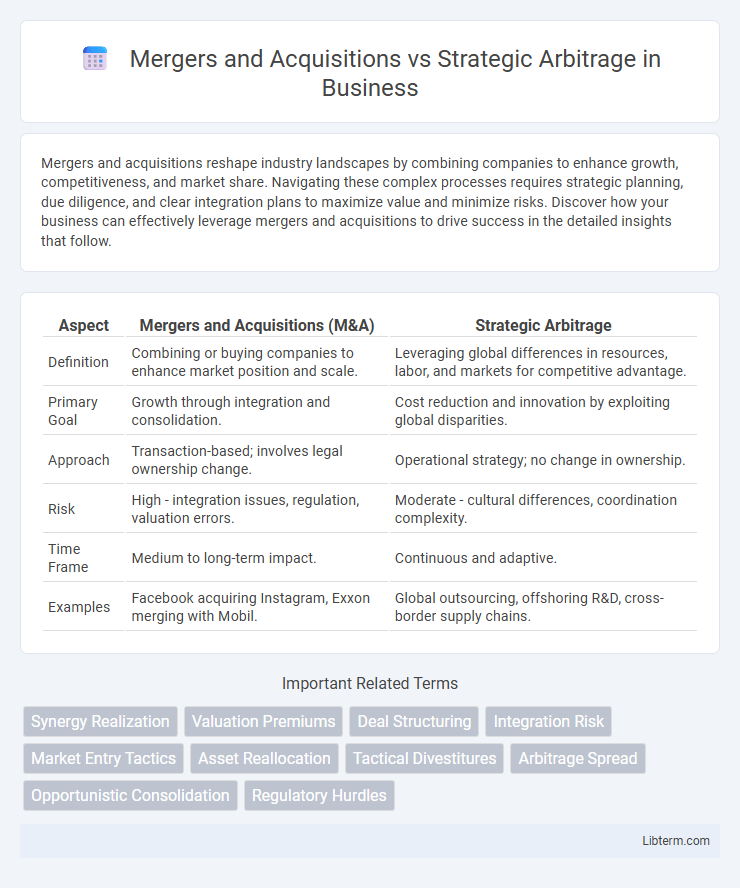Mergers and acquisitions reshape industry landscapes by combining companies to enhance growth, competitiveness, and market share. Navigating these complex processes requires strategic planning, due diligence, and clear integration plans to maximize value and minimize risks. Discover how your business can effectively leverage mergers and acquisitions to drive success in the detailed insights that follow.
Table of Comparison
| Aspect | Mergers and Acquisitions (M&A) | Strategic Arbitrage |
|---|---|---|
| Definition | Combining or buying companies to enhance market position and scale. | Leveraging global differences in resources, labor, and markets for competitive advantage. |
| Primary Goal | Growth through integration and consolidation. | Cost reduction and innovation by exploiting global disparities. |
| Approach | Transaction-based; involves legal ownership change. | Operational strategy; no change in ownership. |
| Risk | High - integration issues, regulation, valuation errors. | Moderate - cultural differences, coordination complexity. |
| Time Frame | Medium to long-term impact. | Continuous and adaptive. |
| Examples | Facebook acquiring Instagram, Exxon merging with Mobil. | Global outsourcing, offshoring R&D, cross-border supply chains. |
Introduction to Mergers and Acquisitions vs Strategic Arbitrage
Mergers and Acquisitions (M&A) involve the consolidation of companies or assets to achieve growth, market expansion, or competitive advantage through synergistic integration. Strategic arbitrage leverages geographic and operational differences, exploiting disparities in labor costs, regulations, or market conditions to optimize business performance and maximize returns. Both approaches serve distinct roles in corporate strategy, with M&A focusing on expansion via structural changes and strategic arbitrage emphasizing cost efficiencies across borders.
Defining Mergers and Acquisitions
Mergers and Acquisitions (M&A) involve the consolidation of companies or assets to achieve growth, enhance market share, or gain competitive advantages. Mergers refer to the combination of two firms into a single entity, while acquisitions involve one company purchasing another to control its operations. These corporate strategies play a crucial role in reshaping industries and driving economic value through synergies and expanded capabilities.
Understanding Strategic Arbitrage
Strategic arbitrage involves leveraging differences in resources, capabilities, or market conditions across regions or industries to gain competitive advantage without full organizational integration, unlike mergers and acquisitions which focus on combining companies. This approach capitalizes on optimizing value through cross-border or cross-sector opportunities by exploiting cost differentials, innovation gaps, or regulatory environments. Understanding strategic arbitrage enables firms to enhance efficiency and growth while minimizing risks associated with large-scale corporate restructuring.
Key Differences Between M&A and Strategic Arbitrage
Mergers and Acquisitions (M&A) primarily involve the consolidation of companies through purchase or merger to achieve growth, efficiency, or market power, while Strategic Arbitrage focuses on leveraging differences in geographic or economic environments to gain competitive advantage. M&A results in ownership and control changes, integrating resources and operations, whereas Strategic Arbitrage capitalizes on disparities such as labor costs, innovation levels, or regulatory frameworks without necessarily changing ownership. The key difference lies in M&A's focus on structural business consolidation versus Strategic Arbitrage's strategic exploitation of external environmental variations for value creation.
Objectives and Value Creation in M&A
Mergers and Acquisitions (M&A) primarily aim to achieve growth, market expansion, and operational synergies by combining complementary assets, capabilities, or market access. The core objective in M&A is value creation through cost reductions, increased revenues, and enhanced competitive positioning, often realized by integrating resources and capabilities. Strategic arbitrage, by contrast, focuses on exploiting differences across geographic or institutional contexts to create value, but M&A value creation is tightly linked to consolidation efficiencies and strategic fit between acquiring and target firms.
Risk Factors in Mergers, Acquisitions, and Arbitrage
Risk factors in mergers and acquisitions include integration challenges, cultural clashes, regulatory hurdles, and overvaluation of target companies, which can lead to financial losses or failure to achieve synergies. Strategic arbitrage involves exploiting differences in markets, expertise, or resources between countries or industries, but risks include geopolitical instability, currency fluctuations, and misalignment of strategic goals. Understanding and mitigating these risks is crucial for success in both approaches to corporate growth and value creation.
Financial Implications and Deal Structures
Mergers and Acquisitions (M&A) typically involve complex deal structures such as stock swaps, cash transactions, or leveraged buyouts, with significant financial implications including debt financing, tax considerations, and goodwill amortization. In contrast, Strategic Arbitrage exploits geographical or operational cost differentials without necessarily merging assets, often resulting in lower upfront capital investment but challenges in aligning financial reporting and regulatory compliance across jurisdictions. The choice between M&A and Strategic Arbitrage impacts capital allocation, risk exposure, and shareholder value creation due to differing financial risk profiles and integration expenses.
Strategic Alignment and Integration Challenges
Strategic arbitrage involves leveraging differences in resources, markets, or capabilities across regions to create value, while mergers and acquisitions (M&A) focus on combining entities to enhance competitive advantage. Strategic alignment in M&A often faces integration challenges such as cultural clashes, operational redundancies, and conflicting management styles that can hinder value realization. Successful integration requires clear communication, unified corporate vision, and aligned organizational processes to overcome barriers and achieve synergy.
Case Studies: M&A vs Strategic Arbitrage Success Stories
The acquisition of WhatsApp by Facebook in 2014 exemplifies successful mergers and acquisitions, leveraging synergies to expand user bases and technological capabilities. In contrast, the strategic arbitrage success of Zara involves optimizing global supply chains by sourcing production in cost-effective countries while maintaining design and marketing operations in high-value regions. These case studies highlight how M&A drives growth through consolidation, whereas strategic arbitrage exploits geographic and economic disparities to enhance competitive advantage.
Conclusion: Choosing the Right Growth Strategy
Choosing between mergers and acquisitions (M&A) and strategic arbitrage depends on a company's long-term goals, market positioning, and resource capabilities. M&A offers direct control over assets and rapid market entry but requires significant capital and integration efforts, whereas strategic arbitrage leverages cost and skill differentials across regions to achieve competitive advantages with lower investment risk. A tailored approach that aligns growth objectives with organizational strengths ensures sustainable expansion and maximizes shareholder value.
Mergers and Acquisitions Infographic

 libterm.com
libterm.com